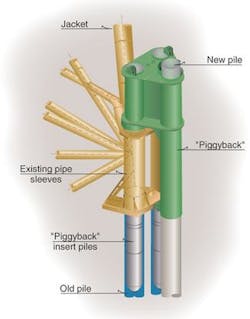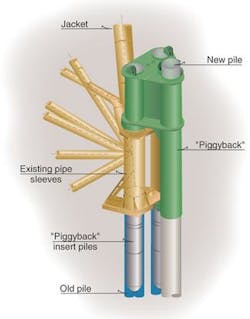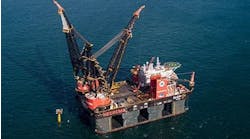High degree of mechanical strength
Aalborg-based Densit produces the Ducorit range of grouting materials, which are claimed to offer a high degree of mechanical strength, low shrinkage, and low heat of hydration. These properties in turn lead to increased compressive strength and improved fatigue performance in treated structures. Offshore, they are applied to strengthen new or aging platform structures such as jacket members, pile sleeves, conductors, and joints. Once mixed with water, the materials are pumped through flexible hoses into pile sleeve connections, annuli, or tubular members.
Last year, the company played its part in three high-profile North Sea projects, the most complex of which involved the new 24-slot steel platform for BP's Valhall water-injection scheme. When installation of the jacket was first attempted in 2002, pile refusal was encountered on five of the eight piles. Rather than commission an entire new installation, BP and main contractor Aker Kvaerner took time out to evaluate structural strengthening requirements with a view to resuming the installation in 2003.
Stronger foundations
One recommendation was stronger foundations for the piles to help secure the jacket to the seabed. A new concept was devised that involved installing an additional pile at two of the jacket's corners by means of a piggyback sleeve. For these to be positioned, the existing piles that experienced driving refusal first had to be cut 3 m above the mud line inside the original sleeves. The new piggyback sleeves would then be connected to those already in place via a combination of a new pile and an insert piece introduced into the existing pile.
High stresses were anticipated in the contact zone on transfer of the load from the existing to the new piles, and further on into the sleeve. The operation demanded a grouted connection with a compressive strength of 160 MPa, more than twice the strength of the original grouting solution supplied by Halliburton. According to Densit's Business Development Manager Lars Mogensen, only Ducorit D1 fulfilled this criterion, but this still had to be proven.
Development program
The company undertook a three-month development program that included a scale test in Norway, witnessed by DNV. It also re-formulated the material as very small aggregate particles (less than 1 mm diameter), with a final compressive strength of 180 MPa. Pre-operation work, including grouting of piles to sleeves 3 m above the mud line, was performed last June without significant problems. In August, the piggybacks were successfully grouted to the old piles, with topsides placement effected 36 hours later. In total, 700 tonnes of grouting material was injected.
Unchartered territory
Last April, Statoil's Kvitebjorn jacket was also installed in the Norwegian sector, with 250 metric tons of Ducorit S5 pumped through the four jacket leg stab-in connection points. The jacket had been built in two sections, which were mated at the offshore site. Connection was effected at an elevation of 143 m below the surface. The water depth was unusually deep for a North Sea jacket, at 150 m. For Densit, operating at this depth also represented uncharted territory. Mock-up tests were arranged in Aberdeen to provide assurances for a successful pumping operation.
null
Another operation for Statoil involved using grout to strengthen the three legs of Dong's Siri platform in the Danish sector. The platform substructure required structural upgrading to handle tie-ins from the Cecilie and Nini oilfields, including a new 150-tonne process module.
"Also," says Mogensen, "the legs needed strengthening, because the platform is sensitive to wave action, and therefore tends to move quite a lot." Ducorit D4 was selected. The work scope involved grout filling the three legs from the bottom up to the first jacking hole.




